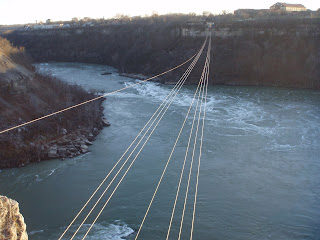Thursday 29th December
Thursday being Market Day in St Jacobs, the next town to Heidelberg, we set off through the snow to go to the Farmers' Market. As some of the farmers are Mennonite, there are shelters for them to leave the horse and buggy.

The Farmers' Market is a large covered building with two floors of market stalls, though the upstairs is just a balcony.

There was a very wide selection of food on the ground floor, meat, poultry, fish, cheese, jams, baked goods, tea and coffee, flowers, herbs, juices, fruits and vegetables.

The vegetable stall, which had the most attractive looking vegetables, was a Mennonite one, you can probably see that the girl behind the counter is wearing a black dress and a black cap.
Upstairs, the stalls are not food ones, though most things are hand made.

I spent a long time looking at the hand-made sheepskin hats and slippers. I was really tempted by the slippers, as my feet are frequently cold.

I spent even longer looking at the Mennonite quilts. I did so want to buy a quilt, they are absolutely beautiful, with geometric or floral patterns, but unaccountably I seem to have taken no pictures at all. Quilting is one of the skills prized by Mennonite women and many of them make quilts, which is often a shared activity.
Then we went into the town of St Jacobs itself, an attractive little town, especially in the snow

It is still decorated for Christmas, and the sales have started, so there were plenty of shops to go into. After a quick lunch, we went to the Visitors' Centre where there is a display called 'The Mennonite Story', explaining their history, beliefs and way of life. I must admit that, while studying history and the Reformation, I had come across religious dissidents called Anabaptists, but I did not realise that many of these turned into Mennonite and Amish groups. They were called Anabaptists because they were opposed to baptism of babies, preferring adult baptism when the person was old enough to make a free choice. They also believe that work is more satisfying than consumption, and that tradition should be valued more than change. There were lots of explanations, photographs and videos, and this example of a Meeting House

There is no altar, cross or stained glass. The jug is for communion wine, there is a loaf of bread on the other end of the desk.
We continued to another building where we visited the Maple Sugar Museum. Maples grow in many areas, but it is only in the north eastern part of North America that maple sugar can be made from them. The sap does not seem to rise in the same way in other areas. The trees are tapped in March and April, and the sap collected in buckets. The water in it then has to be evaporated. This is how the early pioneers did it

The museum had a replica sugar shanty, with more up-to-date methods.

This is an evaporator, where the sap is boiled as it passes from section to section. It takes 30 - 40 litres of sap to make one litre of syrup.
When we went back out into the street, we saw a horse buggy approaching, and I was able to take a picture.

This was a great triumph; I had been trying very hard to get a picture, but my camera was not sufficiently responsive to take a picture as we drove past one. So far, I had photographed the road ahead of the buggy, the horse's nose, the horse's head, and even the horse itself, but I never managed to get the whole thing. This time it was easier because I was standing in the street. This is a winter buggy, the summer ones are open. The driver of this one was going quite fast, the horses were cantering, and I'm not sure whether it was the cold or the need to get away from the horrible tourist cameras. So I did feel a bit guilty if the driver objected to a photograph, but I don't need to take any more.
On the way home, we passed a couple of open buggies outside the school house, so I managed another photograph, one with no people this time.

Because it was snowing and very cold, the horses are wearing coats. These are open buggies, so I imagine the drivers and passengers must have needed to be warmly wrapped.
The countryside around is picturesque in the snow.

This is a typical looking Mennonite farm. Agriculture is the preferred means of livelihood in this community. Most depend on dairy, beef, pigs and poultry. Grain, fruit and vegetables may also be grown. The barn is high, like this one, and there is usually at least one grain silo. Most farming is done by older and smaller machinery than is in use on other, non-Mennonite farms. Some Mennonite farmers refuse to use tractors, and use horses instead. Some permit electricity in both the home and the farm, some use it only for farming. Things for sale, like eggs or maple syrup, are advertised at the farm gate. It usually says 'Not Sundays'.
Posted using BlogPress from my iPad

















































